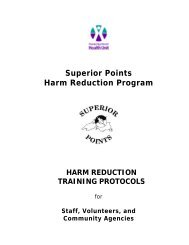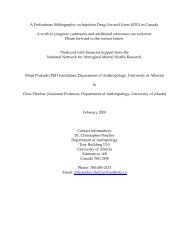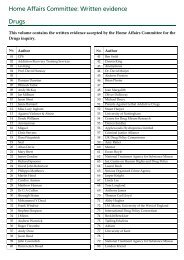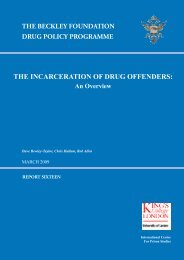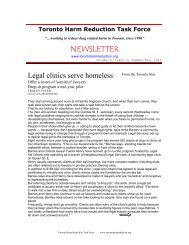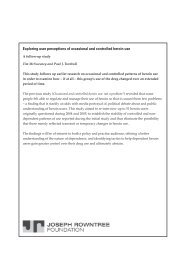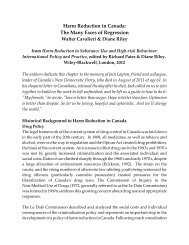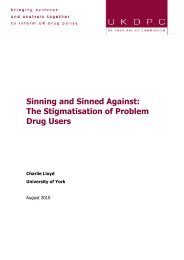Canadian Journal Addiction Medicine - Canadian Harm Reduction ...
Canadian Journal Addiction Medicine - Canadian Harm Reduction ...
Canadian Journal Addiction Medicine - Canadian Harm Reduction ...
Create successful ePaper yourself
Turn your PDF publications into a flip-book with our unique Google optimized e-Paper software.
Prevalence of Illicit Methadone Use as shown in<br />
New Patients entering a Methadone Maintenance<br />
Treatment Program<br />
November 2012<br />
Carolyn Plater-Zyberk MSW, Michael Varenbut, MD,<br />
Jeff Daiter, MD, Andrew Worster, MD<br />
Affiliations:<br />
Ontario <strong>Addiction</strong> Treatment Centre’s Head Office<br />
13291 Yonge St., Ste. 403<br />
Richmond Hill, ON, Canada L4E 4L6<br />
Corresponding Author Contact:<br />
Carolyn Plater-Zyberk<br />
13291 Yonge Street Ste. 403<br />
Richmond Hill, Ontario, Canada, L4E 4L6<br />
647-200-1248<br />
cplater@toxpro.ca<br />
Abstract<br />
Background: While there are significant harms and dangers<br />
associated with illicit methadone use, the exact scope of the<br />
problem is largely unknown. However, we do know that annual<br />
deaths from methadone are rising and the literature indicates<br />
that a significant number of these deaths are directly related<br />
to illicit methadone use. Given this, methadone diversion<br />
should be a primary concern for all methadone providers and<br />
treatment programs.<br />
Methods: We conducted a medical record review of<br />
consecutive admissions to a large methadone maintenance<br />
treatment program over a 4-year period to determine the<br />
prevalence of confirmed methadone use prior to methadone<br />
treatment initiation.<br />
Results: 5805 records were examined; a total of 5144 met<br />
the criteria as a “new initiate” on mmtp. Of these 5144 new<br />
initiates 1062 (20.6%) were identified via urinalysis to have<br />
illicit methadone present.<br />
Conclusions: Our study shows the prevalence of<br />
illicit methadone use in patients initiated on methadone<br />
maintenance over a 4-years period to be at least 20.6%.<br />
Introduction<br />
Methadone is a synthetic opioid used in the treatment of opioid<br />
dependency (CPSO, 2005). When taken within the context<br />
of a Methadone Maintenance Treatment Program (MMTP)<br />
as a prescribed medication, methadone is considered a safe<br />
treatment with significant benefits (CPSO, 2005). Prescribed<br />
methadone helps to prevent withdrawal symptoms associated<br />
with opioid use, reduces opioid drug cravings, blocks the<br />
effects produced by other shorter acting opioids and improve<br />
one’s overall daily functioning (Breslin & Malone,2006;<br />
Seymour et al, 2003). On a greater societal level, methadone<br />
maintenance treatment has been associated with a reduction<br />
of illicit opioid drug use, reduction in crime rates, reduction in<br />
mortality and morbidity rates associated with opioid use and<br />
an overall enhancement in social productivity (CPSO, 2005;<br />
Lewis, 1997).<br />
As an opioid with a long half-life, methadone has a high<br />
potential for opioid toxicity and death even when prescribed<br />
by health professionals (CPSO, 2005). This potential for<br />
toxicity is increased significantly when ingested with other<br />
sedating chemicals. In fact, just 10 mg of methadone can be<br />
enough to kill a child and 30 mg-50 mg can be enough to<br />
kill an opiate naive adult (CPSO, 2005), evidence of this is<br />
reported in the literature on methadone related deaths (CPSO,<br />
2005; Seymour et al 2003; Fountain et al, 2000; Cicero, 2003;<br />
Green et al, 2000).<br />
In part because of its long-acting effect, there exists a substantial<br />
black market for methadone (Fountain et al, 2000; Bell & Zador,<br />
2000; McDermott & McBride, 1993). The primary source of<br />
methadone diversion is when individuals sell their prescribed<br />
take home doses (“carries”) of methadone for profit (Lauzon et<br />
al, 1994) or give to someone other than whom it was prescribed<br />
(Lauzon et al, 1994). Individuals are granted the privilege of<br />
earning take home doses on the basis of demonstrated clinical<br />
stability, however, a review of the literature demonstrates that<br />
many individuals with these take home dose privileges actually<br />
misuse the doses they are given (Varenbut, et al , 2007). Even<br />
when prescribed methadone is consumed within a clinic or<br />
pharmacy as a monitored medication, some individuals still<br />
retain part of their dose in their mouth and then spit it back,<br />
when they leave (Lauzon et al, 1994; Lancelin et al, 2005). This<br />
“spit back” is then later sold or given to other individuals of<br />
whom it was not prescribed. Pharmacy theft of methadone<br />
also contributes to the illicit methadone problem (Lauzon et al,<br />
1994). Lastly, methadone prescribed for the treatment of pain, is<br />
another likely source of diversion, as the regulations governing<br />
this are much more lax with respect to dosage, take home doses,<br />
and overall program compliance monitoring. Research reveals<br />
a direct correlation in methadone related deaths with increases<br />
in methadone prescribing for pain management (Paulozzi LJ et<br />
al, 2006).<br />
10




